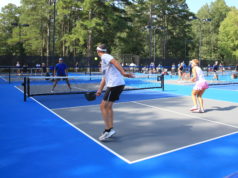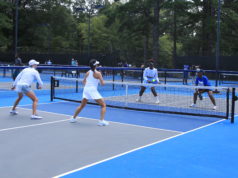YOU’RE OUT OF ORDER
During a makeup doubles match, our opponent served her service game. We switched sides and then her partner served (rather than our team serving). I then began to serve and realized we had messed up. We decided that the opponent should serve again as to correct the service order. That gave her two consecutive serves. Were we right?
Celia Sheridan, Junior Leagues Vice President
No, you were not right. You were correct in that the games that were played in error were played in good faith and therefore stood. However, when the error was realized, whoever was to serve after your opponent should have served and this would become the new service order. According to “USTA Rules of Tennis,” Rule 27c Correcting Errors: If a player serves out of turn during a standard game, the player who was originally due to serve shall serve as soon as the error is discovered. However, if a game is completed before the error is discovered the order of service shall remain as altered.
_______
NOT BEING COURTSIDE JEOPARDIZES DEFAULT
During a recent match, I exchanged cards with the opposing captain prior to the match. Our opponents did not have players listed at line 5 and notated “default” at that line. I proceeded to call my line 5 players and let them know that they didn’t need to show up because the other team was defaulting. The other captain then informed me that those players had to be there to receive the point. Was she correct?
Jane Milton, Thursday Women Vice President
This scenario happens quite frequently. When a team notifies their opponent ahead of time that they are defaulting a line, the accepting team doesn’t have their players present at the courts. Although it may be a courtesy, by definition, both teams would be in default and no point awarded for that line. In the ALTA General Rules, the definition of a default is the loss of a match or matches by failing to be present for play within 20 minutes after the scheduled starting time. The default does not happen when the captain notifies the opposing captain that they don’t have players for that particular line. The default happens when the default time comes and goes on the scheduled match day. So, if neither team had players at the court at the default time then both are in default and no point will be awarded for that line. So, if you want to take a point by default you must have legal players there to receive the point.
_______
ACT QUICKLY FOR ROSTER REMOVAL
I was put on a roster and never played at all. Can I be deleted from that roster?
Holly Underwood, Sunday Women Vice President
According to Rule I.G.4, “No player may be removed from a roster after the roster correction deadline, regardless of how they came to be on that roster.” However, if you were on a roster and did not play a single match or were not credited with a win by default, you have 30 days from the completion of the week 7 match to contact the ALTA office and have yourself expunged from that roster.
_______
RACQUET SPIN ETIQUETTE
We finished warming up and did the racquet spin. Our opponent won the spin and said: We choose to make you choose first. I said you cannot do that. You must choose serve, receive or side. He said no, we can also choose to make you choose first. Can you tell me the rule on this?
Joyce Vance, First Vice President
After warm-up and the racquet spin, players are accustomed to the winner of the spin selecting serve or receive and the opponent selecting the opposite. USTA “Friend at Court, ITF Rules of Tennis,” states:
Choice of Ends and Service, The player/team who wins the toss may choose:
A. To be server or receiver in the first game of the match, in which case the opponent(s) shall choose the end of the court for the first game of the match; or
B. The end of the court for the first game of the match, in which case the opponent(s) shall choose to be server or receiver for the first game of the match; or
C. To require the opponents(s) to make one of the above choices.
Per the rule of Friend at Court, your opponent gave you selection C (requiring you to make the choice). Your opponent acted within the rules when requiring you to make the selection.




